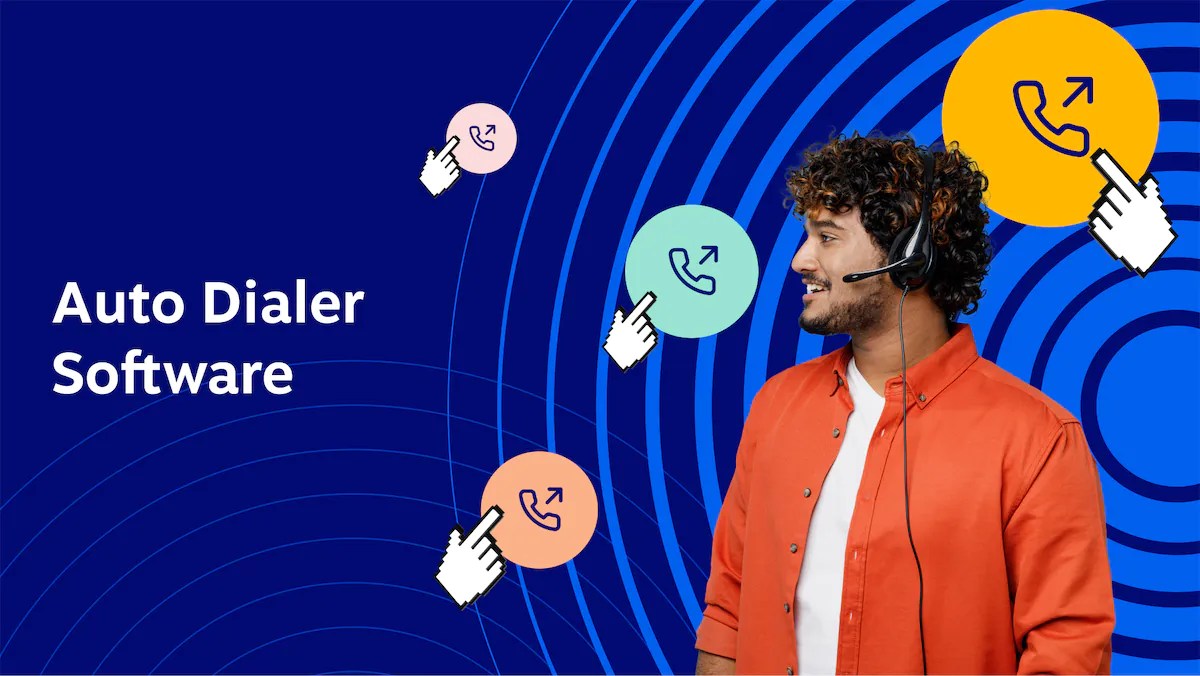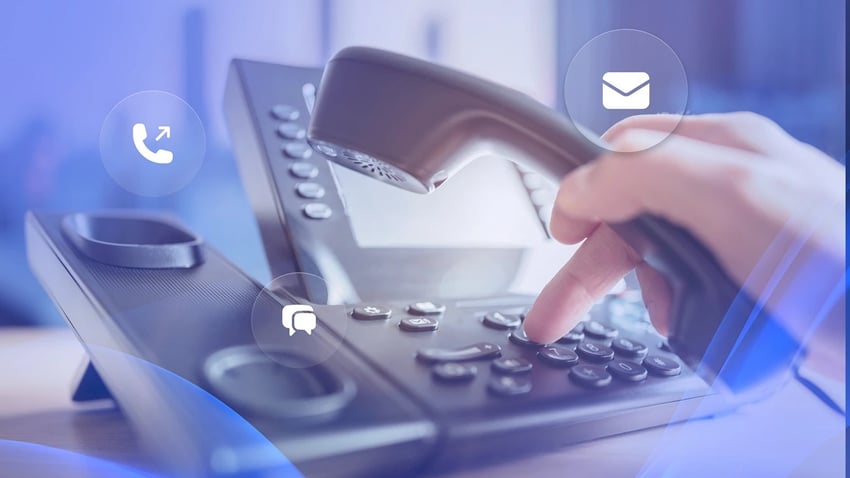Sales and support reps spend hours manually dialing numbers and waiting on hold. Since 70% of employees see the greatest potential for automation in reducing the time spent on repetitive tasks, auto dialing is becoming even more important in daily call center operations.
And that’s where auto dialer software comes in. It automates outgoing calls and voicemails, allowing your agents to make more calls and reach more customers each day. Thanks to auto dialing technology, your team can focus on value-added tasks — like making more sales and resolving key customer issues — instead of staring at a keyboard.
We’ll explain how auto dialer systems work and show you real-world examples of how businesses use them to increase reach, customer loyalty, and profits. But first…
Key Takeaways and Auto Dialer Software at a Glance
What it is: Auto dialer software automates the outbound calling process, filtering out busy signals and voicemails to connect agents only with live humans.
The ROI: By eliminating manual dialing and wait times, teams can increase call volume by up to 300% (3x more conversations per agent/day).
Dialer types:
- Predictive: Best for high-volume speed (B2C).
- Power: Best for zero-delay connections (B2B sales).
- Progressive: Best for research-heavy calls (account management).
Compliance: Auto dialers must support STIR/SHAKEN attestation to prevent your calls from being blocked or flagged as spam by carriers.
Top software recommendation: Nextiva. It combines a multi-mode auto dialer with AI-powered transcription, omnichannel messaging, SMS, and CRM integration for a complete sales operation.
What Is Auto Dialer Software?
Auto dialer software is a call center technology that automates your outgoing call process. Since manual keypad entry is eliminated, agents can seamlessly transition from one call to the next.
An automatic dialing system dials numbers from a predefined list and filters out irrelevant results such as busy signals, voicemails, or unreachable numbers. It only connects the call to an agent when a representative answers. This allows your team to focus more on the conversation at hand instead of wasting time manually dialing.

Key features of auto dialers
Although individual tools vary, a high-performing auto dialer offers the following features:
- Intelligent call routing: Automatically routes connected calls to the most suitable available agent based on skills or territory.
- CRM integration: Synchronizes with platforms like Salesforce or HubSpot to log call activity and instantly view customer data.
- Voicemail detection: Distinguishes between a human voice and a voicemail greeting to save agents’ time.
- Voicemail drop: Allows agents to leave a pre-recorded, professional voicemail message with a single click, instantly freeing them to take the next call.
- Customizable dialing modes: Provides flexibility between speed (predictive) and agent control (power/preview).
- Call recording and monitoring: Allows managers to listen in (monitor), whisper to agents (coach), or barge in (assist) for quality assurance and training.
- Real-time analytics: Offers live dashboards that track current agent status, call volume, and campaign success rates as they happen.
- Workflow automation: Triggers post-call actions automatically, such as sending a follow-up SMS or email based on the call disposition.
- Compliance tools: Provides built-in safeguards that scrub lists against Do Not Call (DNC) registries and enforce dialing curfew hours.
- STIR/SHAKEN readiness: Ensures your calls are authenticated and not flagged as spam on customer devices.
Who uses auto dialers?
While automatic dialers are indispensable for busy sales teams, many other industries also use these versatile tools. Here are a few examples:
- Healthcare: For appointment reminders and patient follow-up.
- Debt collection: For efficiently managing large incoming payments.
- Market research: For conducting surveys and collecting data at scale.
- Political campaigns: For voter outreach and fundraising.
Regulatory note: Powerful tools require responsible use. In the US, the Telephone Consumer Protection Act (TCPA) establishes strict guidelines for auto dialers, including obtaining prior consent for calls to mobile phones. Businesses must also adhere to STIR/SHAKEN protocols to verify caller ID. Using compliant software is the best way to protect your brand reputation and avoid penalties.
Benefits of Auto Dialer Software
When used effectively, automatic dialing systems do more than just dial numbers faster. They change the profitability of your contact center. Here are the key benefits for growing businesses.
1) Fast deployment and easy operation
Complex on-site hardware installations are a thing of the past. Auto dialers are cloud-based and user-friendly, allowing businesses to be up and running quickly.
With intuitive user interfaces, your employees can make calls immediately without lengthy training. Most auto dialer solutions run directly in the web browser and require no additional equipment beyond a headset and an internet connection.
2) Scalability on demand
Auto dialers grow with your business. Whether you’re a small business hiring your first sales force or a large enterprise managing seasonal peaks, cloud-based dialers let you add or remove licenses instantly.
You can purchase additional licenses as needed without investing in new hardware or office space and efficiently support your distributed teams and remote employees.
3) Maximized agent talk time
The biggest threat to agent productivity in outbound sales is idle time — the time agents spend dialing, waiting for calls, or handling dropped calls.
Automated phone calling using auto dialers keeps agents active only when a caller is on the line. The software automatically queues missed calls and archives invalid numbers, ensuring an uninterrupted workflow.
4) Reduced operating costs
Manual dialing is expensive because you pay agents for downtime. On average, employees switch between applications approximately 3,600 times per day, resulting in manual errors and inefficiencies.
Increasing the number of calls per agent per hour helps you reduce your cost per contact. Automation also helps eliminate errors and improve agent productivity. With more calls per hour, your customer acquisition costs (CAC) decrease while your revenue potential increases.
5) Enhanced lead management & data hygiene
Integrating your auto dialer with a CRM (like Salesforce, HubSpot, or Nextiva) helps you keep track of important leads. Call outcomes (answered, voicemail, interested) are logged automatically, keeping your data clean.
When a call connects, the agent sees the customer’s history instantly. For example, Nextiva users can access real-time conversation history and AI summaries to drive better outcomes.
Types of Auto Dialers and Choosing the Right Mode
Not all auto dialers work the same way. The main difference is the call control algorithm — how the software decides when to make the next call, and how much control the agent has. Here are the four standard dialing modes:
1) Predictive dialer
A predictive dialer is designed for speed. It uses a mathematical algorithm to predict agent availability and dials multiple phone numbers simultaneously before the agent has finished their current call. Busy signals, voicemails, and unanswered calls are filtered out, so the first call is immediately connected to the available agent.
- Best for: High-volume B2C telemarketing, debt collections, and surveys where the goal is maximum answer rates.
- The trade-off: While this method offers the highest throughput, it carries the risk of dropped calls. If a customer answers, but no agent is available, the connection is terminated.
Note on regulatory compliance: To use a predictive dialer legally, you must strictly monitor your call drop rate (limited to 3% in federal regulations) and ensure that you do not call any numbers listed on the Do Not Call Registry.
👉 You may also like: How to Create a Predictive Dialer Campaign
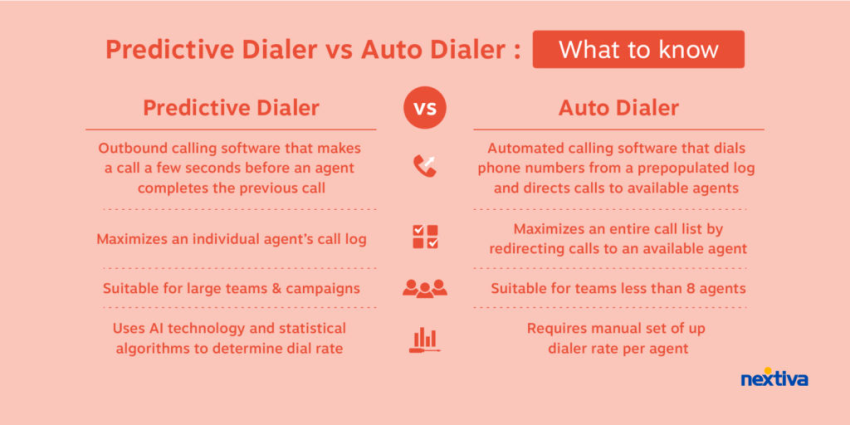
2) Power dialer
A power dialer (also called a parallel dialer in certain contexts) operates on a one-to-one basis. Once an agent hangs up, the system automatically dials the next number in the list. Unlike predictive dialing, the agent is already online when the customer answers.
- Best for: Sales teams that prioritize an optimal customer experience. It reduces dropped calls and eliminates the need for manual number entry.
- Why it’s popular: It offers agents a consistent work rhythm without the high pressure and associated overload that can occur with predictive algorithms.

3) Progressive dialer
A progressive dialer is a hybrid solution. It displays the customer’s CRM record to the agent before the call. Simultaneously, it ensures a smooth workflow by automatically initiating the call after a preset timer (e.g., 30 seconds).
- Best for: Account management and contract renewal teams. It gives agents just the right amount of time to review the customer history (“Oh, the customer purchased plan X last year”) before making the call.
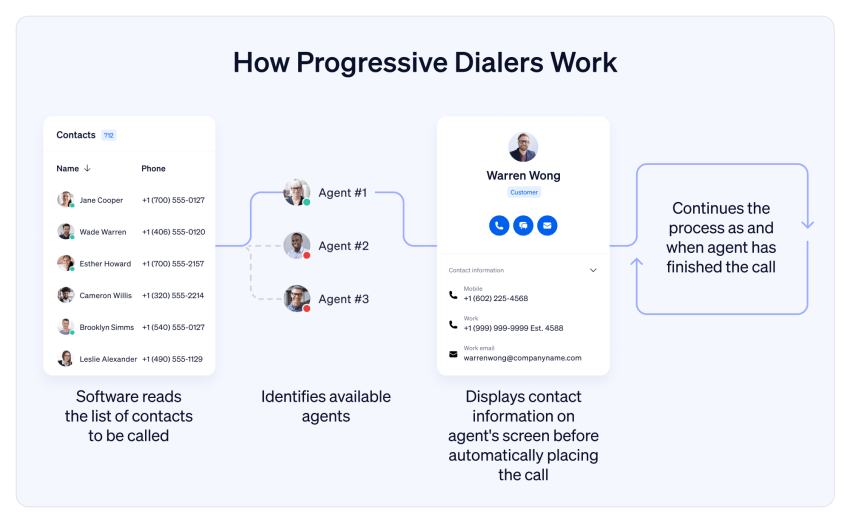
4) Preview dialer
In a preview dialer, the software displays information about the next contact before connecting the call via CRM integration. This enables agents to tailor their approach and prepare effectively for the conversation. It’s like a call pop for inbound calls, but in reverse.
Unlike predictive dialing, the power to initiate the call lies with the agent, allowing sufficient time to prepare and fully engage with the customer.
- Best for: Complex B2B sales, high-ticket closing, or sensitive support callbacks where extensive research is required before speaking.
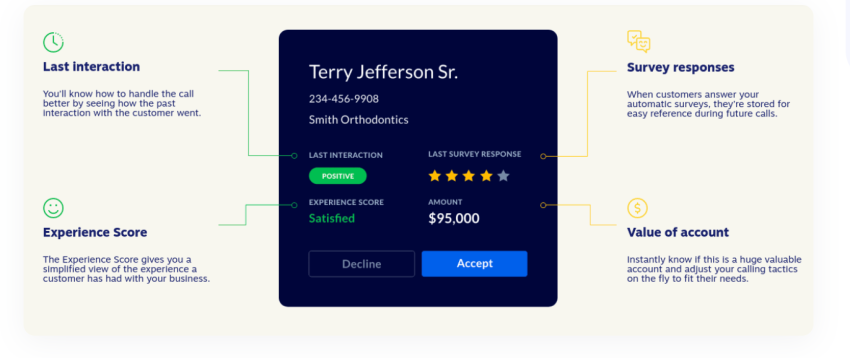
Which auto dialer type do you need?
| Type | Speed | Agent prep time | Key use case |
|---|---|---|---|
| Predictive | ⚡⚡⚡⚡ | None | Telemarketing, Debt Collection |
| Power | ⚡⚡⚡ | Low | Inside Sales, Fundraising |
| Progressive | ⚡⚡ | Medium | Customer Retention, Upselling |
| Preview | ⚡ | High | Complex B2B Sales, High-Tier Support |
What is voice broadcasting?
Voice broadcasting is a dialing mode that delivers a prerecorded message to a large list of contacts. While not a conventional dialer type, it’s ideal for reminders, surveys, and general announcements.
Key features:
- Broadcasts prerecorded messages to a large number of contacts simultaneously.
- Efficient for one-way communication without the need for live agents.
- Suitable for reminders, surveys, and general announcements to a wide audience.
Best Auto Dialer Software for Call Centers
While there’s no one-size-fits-all solution, the following call center auto dialer platforms work best for sales and support teams.
1) Nextiva
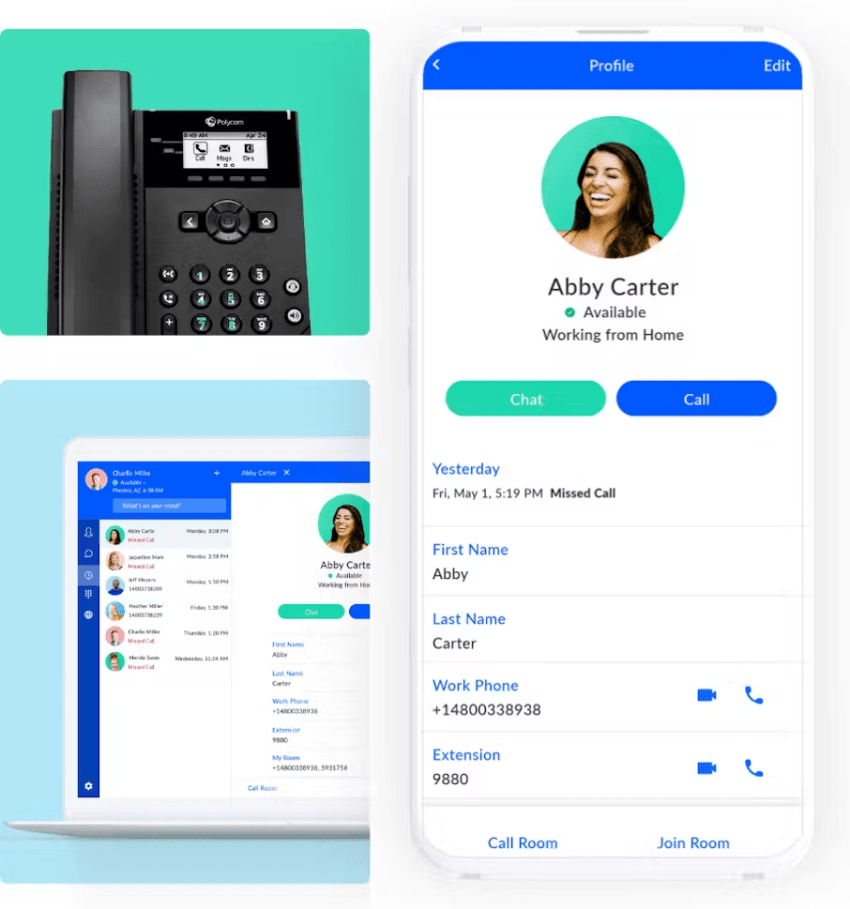
Best for: Growing businesses and corporations that need a unified customer experience (CX) platform.
Nextiva is a unified cloud communications platform for dynamic call center teams. The platform integrates a multi-mode auto dialer (predictive, progressive, and power) directly into omnichannel communications using VoIP technology.
Key dialer features:
- Unified view: Threaded conversations allow agents to switch between voice, text, and video calls in a single view.
- AI advantage: AI-powered transcription, automatic call summarization, and sentiment analysis to enable managers to effectively coach their agents.
- Integrations: Comprehensive native integrations with Salesforce, HubSpot, Microsoft Teams, and Zendesk offer a unified customer view.
2) RingCentral
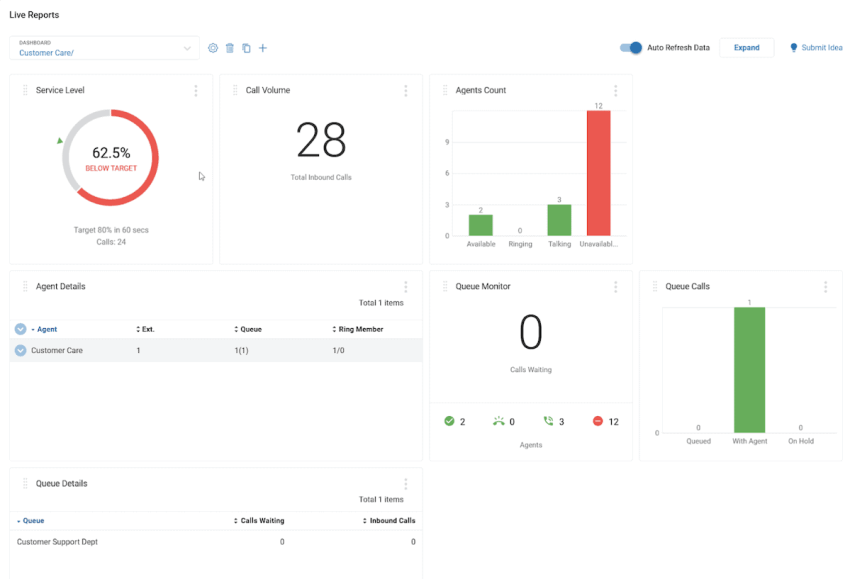
Best for: Large organizations with a need for high-performance workforce management.
RingCentral offers a reliable auto dialer within its unified communications suite. Its workforce optimization (WFO) features make it a good choice for large contact centers that need to manage complex shift schedules in addition to dialing.
3) Five9
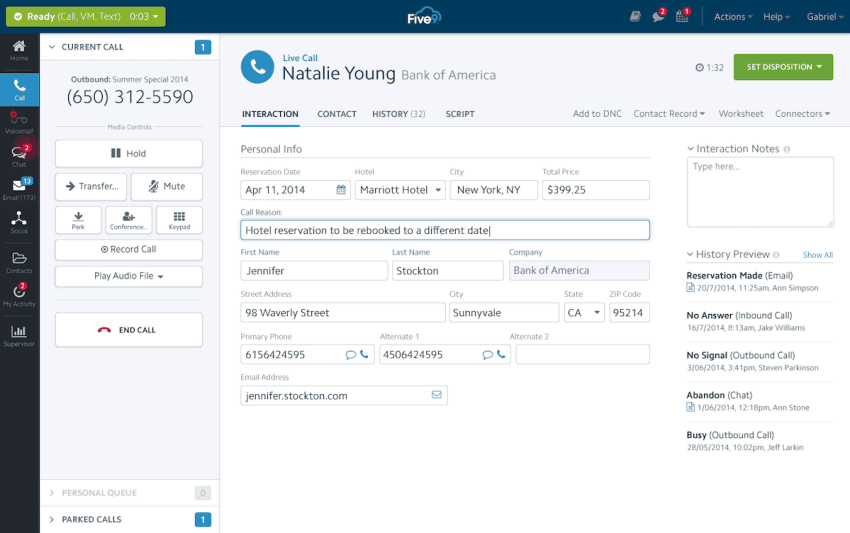
Best For: Complex, enterprise-level technical configurations.
Five9 is an established cloud contact center provider. Its auto dialer is highly customizable and supports complex routing rules. It’s preferred by companies with their own IT teams that need to create custom workflows, although its user interface can have a steeper learning curve compared to newer competitors.
4) Aircall

Best for: SMBs and support teams that extensively use helpdesk tools.
Aircall stands out for its simplicity and intuitive operation. It integrates with helpdesk tools like Intercom and Help Scout. While it doesn’t offer the level of detail found in enterprise solutions, its ease of use makes it popular with startups and support teams.
5) PhoneBurner
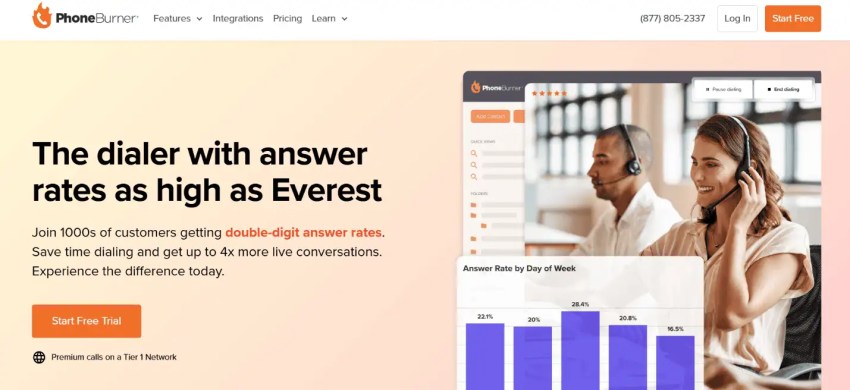
Best for: Remote sales teams focused exclusively on power dialing.
PhoneBurner is a specialized power dialer tool (without a predictive algorithm). Its unique approach to telephony helps avoid the typical call setup delay. It’s a good niche solution for distributed sales teams that want to process call lists quickly and efficiently without needing complex contact center functionality.
Auto dialer software comparison
| Solution | Dialing modes | Top integration strength | Best for |
|---|---|---|---|
| Nextiva | Predictive, power, progressive | Unified CRM & AI analytics | All-in-one sales & support |
| RingCentral | Predictive, power | Workforce management | Enterprise workforce ops |
| Five9 | Predictive, progressive | Custom API workflows | Complex IT requirements |
| Aircall | Power only | Helpdesk (Intercom/Zendesk) | Startup support teams |
| PhoneBurner | Power only | Remote sales tools | Solo/remote sales reps |
Choosing the Right Auto Dialer Software for Your Business
When buying an auto dialer, follow this quick framework to build your list:
1) Define your key technical specifications
Before seeking vendors, assess your existing infrastructure.
- Compliance: If you’re calling mobile numbers, your dialer must support STIR/SHAKEN attestation (caller ID verification) to avoid being flagged as spam. Specifically ask if the vendor supports “A-level attestation.”
- CRM integration: Don’t settle for simple integration. You need a dialer that can retrieve contextual information (previous purchases, support tickets) before connecting.
- Reliability in remote work: If your employees are working remotely, look for a cloud-native solution that doesn’t require VPNs or high-performance hardware.
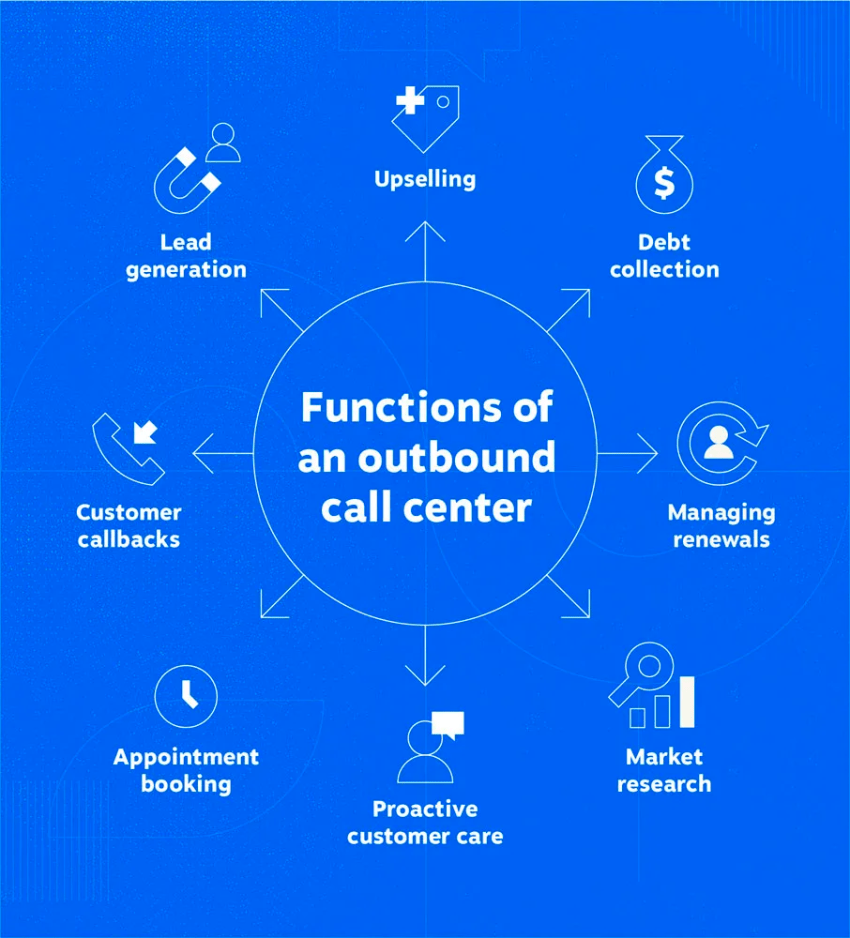
2) Match the dialer to your team’s goals
Different teams need different solutions.
- B2C sales with high call volume: To handle a high lead volume, you need a predictive dialer with voicemail detection (AMD).
- B2B sales with personal support: For instant calls and optimal preparation of your employees, you need a power dialer or click-to-call solution.
- Customer support: For callbacks and automated notifications, you need a dialer with interactive voice response (IVR) integration.
3) Evaluate vendors
Sales demos focus on eye-catching features. Ask these three questions:
- Do you charge extra for local number portability (calls from the local area code)? Many vendors omit this cost.
- What is your average Service Level Agreement (SLA), and do you offer 24/7 support? Essential if your teams work in different time zones.
- How does your platform handle dropped calls or abandoned calls to ensure TCPA compliance? If this question cannot be answered clearly, you should look for another vendor.
4) Try before you buy
Never sign a contract without a proof of concept. A reputable provider should offer a transparent trial period.
- Test call quality: Have an employee use the test software to call you on your mobile phone. Are there any delays? Is the voice quality clear?
- Test data flow: Does the call appear in your CRM system immediately after hanging up?
Pro tip: Don’t just buy a dialer, buy a platform. Standalone dialers can lead to data silos. Integrated platforms (like Nextiva) offer the greatest added value, as they combine dialer, business phone system, and team chat in a single subscription.

Best Practices for Effective Auto Dialing
Without the right safeguards, even the most powerful auto dialer can damage your brand reputation. To achieve results while remaining compliant with the law, follow these best auto dialing practices.
Meet compliance requirements
Make sure your dialer signs calls with Level A attestation. This signals to mobile carriers that you (the caller) are authorized to use that phone number and prevents your calls from being blocked or marked as spam. Under the TCPA, you generally need prior, explicit written consent to automatically call mobile phones for marketing purposes.
Also, configure your software to automatically block calls before 8:00 a.m. and after 9:00 p.m. in the recipient’s local time.
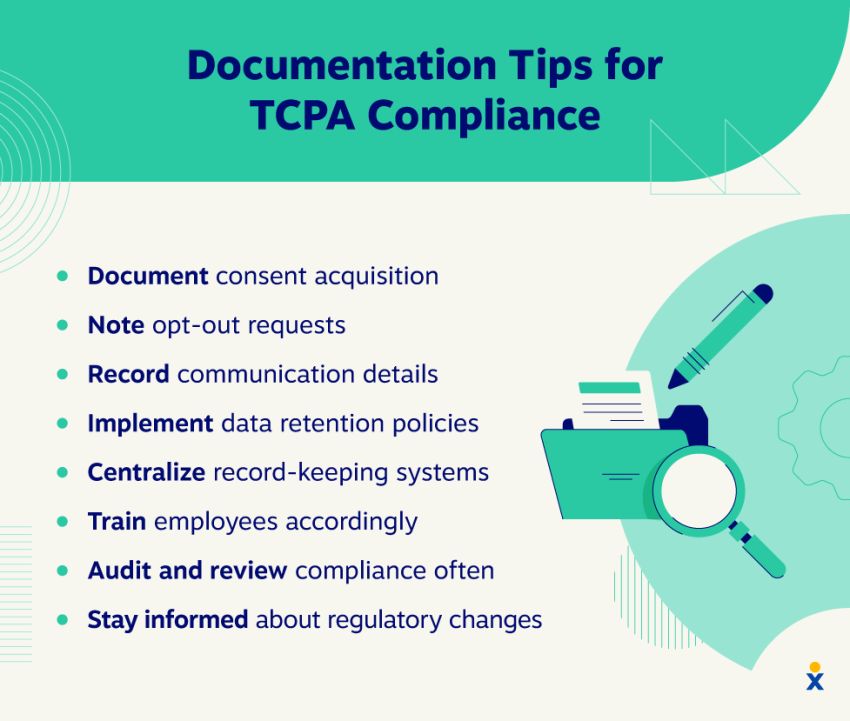
Prioritize data hygiene
A dialer is only as good as the list you provide it.
- Clean up DNC lists: Automatically synchronize your internal DNC list and the national DNC registry with your dialer every 24 hours.
- Remove plaintiff numbers: Modern dialers can now identify and block known plaintiffs who involve businesses in TCPA lawsuits.
Balance automation and human touch
Efficiency shouldn’t replace empathy.
- Smart routing: Use sticky routing to connect prospects to the same agent they last spoke with.
- Limit call frequency: Set a limit on call frequency (e.g., a maximum of 3 attempts per week) to avoid bothering your leads and overloading your list.
Why Auto Dialers Are Essential for Large Sales Teams
Scaling a sales team meant hiring more people. Today, it means better technology. As teams grow, the complexity of managing leads increases exponentially. Without automation, sales reps waste their time sifting through lists and listening to ringtones.
The advantage of parallel dialing
For enterprise teams, parallel dialing (a feature of auto dialers) is a real breakthrough. Employees can dial multiple numbers at once. The software recognizes greetings, discards voicemails and busy signals in milliseconds, and connects the employee to the caller instantly.
Result: Employees spend 45 minutes per hour on calls instead of just 15.
AI-powered context
AI dialers can not only connect calls but also optimally prepare agents. AI listens in on the call and displays battle cards on the agent’s screen with answers to difficult objections. Managers can see a dashboard of live calls, color-coded according to sentiment (e.g., angry vs. satisfied), and can intervene if necessary.
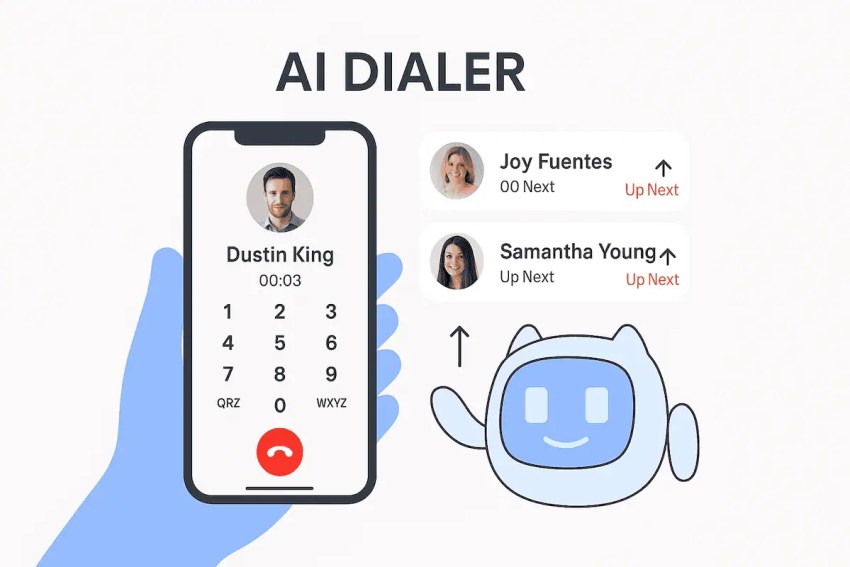
Try Nextiva for Scalable, Smart Sales Enablement
Nextiva’s integrated ecosystem enables a unified customer experience. For sales and support teams that need to act quickly and reliably, Nextiva unifies their outreach strategy with features like:
- Omnichannel reach: If a prospect doesn’t answer, you can automatically send a follow-up text or email from the same dashboard.
- AI-powered transcription: Every conversation is automatically transcribed, allowing you to search for keywords later.
- AI summaries: A concise summary of the conversation is generated and transferred to your CRM system, saving your team time for follow-up.
- Unified data: Thanks to native integrations with Salesforce, HubSpot, and Zoho, Nextiva ensures your dialer data is available wherever your sales team works.
- High uptime: With a 99.999% reliability rating, your sales floor remains operational at all times.
Don’t dial blind. Dial smart.
Thinking of outbound sales as a mere numbers game is outdated. With Nextiva, you shift your focus from quantity to value. Join over 100,000 companies that use Nextiva to transform cold calling into long-term customer relationships.
Using an Auto Dialer With Nextiva
Nextiva meets the key criteria of a reputable and compliant provider. If you wish to use your own third-party auto dialer software with Nextiva’s SIP trunking service, we fully support it provided you adhere to the rules.
The most important rule: Nextiva permits auto dialers as long as they are used for legitimate business purposes and the call rate doesn’t exceed one call per second. If your dialer software allows for an adjustable call rate, please limit it to this value to ensure smooth operation and compliance with our network policies.
Scale outbound with peace of mind.
Get a demo to see how Nextiva scales your call center performance.
Auto Dialer Software Frequently Asked Questions (FAQs)
No, automatic dialers are legal in the US, but they are subject to strict regulations. They must follow the TCPA (Telephone Consumer Protection Act) (e.g., obtaining consent for calls to mobile phones) and the STIR/SHAKEN protocols (caller ID verification). It’s illegal to use numbers listed on the Do Not Call list or to use them for fraudulent purposes.
Prices typically range from $40 to $150 per user per month. Basic power dialers are less expensive, while enterprise predictive dialers with AI features cost more. Unified platforms like Nextiva offer the best value, as they integrate the dialer with your business phone system and CRM tools.
This is the percentage of calls where the dialer connects to the customer, but no agent is available. To meet FTC requirements, your abandonment rate per campaign must be below 3%.
Sales: For cold calling and lead qualification.
Healthcare: For appointment reminders.
Real Estate: For prospecting home sellers.
Collections: For payment reminders.
Political Campaigns: For voter outreach (GOTV).

















 VoIP
VoIP 

